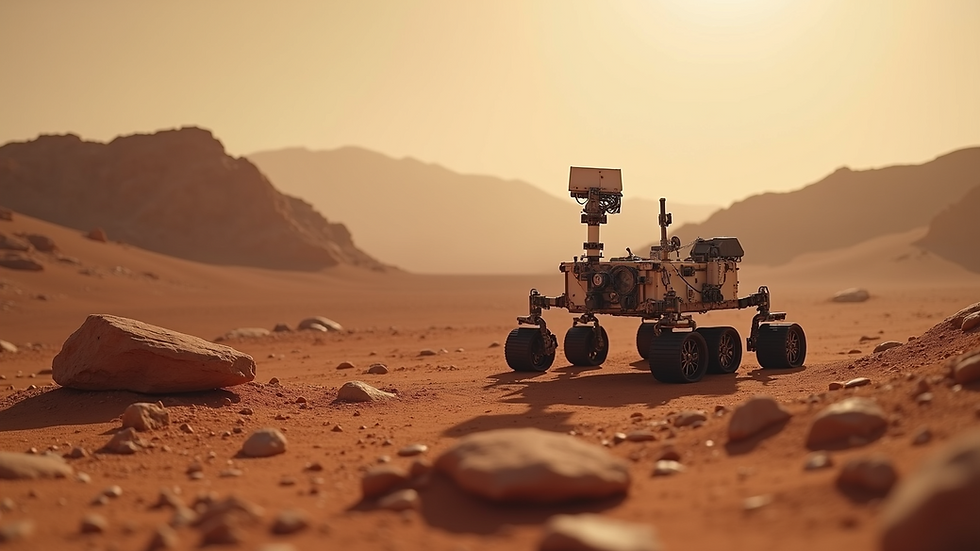Latest News in Space Exploration: Missions and Discoveries
- Phystroid

- Jul 25
- 4 min read
Updated: Jul 28
Space exploration continues to advance at an incredible pace, with new missions and discoveries consistently reshaping our understanding of the universe. In this blog post, we'll analyze the most recent developments in space exploration, covering everything from Mars missions to the latest achievements in scientific research.
Latest Space Exploration News
One of the most exciting developments in the field of space exploration is the continued exploration of Mars.NASA's Perseverance rover, which landed on the Martian surface in February 2021, is now actively collecting samples that could provide insights into the planet's past. These samples are expected to be returned to Earth by the 2030s, opening up new possibilities for understanding Martian geology and the potential for past life.

The Perseverance rover is equipped with advanced scientific instruments designed to analyze soil and rock samples. This data may help scientists determine if life ever existed on Mars. In addition, the rover has been testing a technology to produce oxygen from the Martian atmosphere, paving the way for future human missions.
One significant aspect of the ongoing efforts on Mars is the collaboration between international space agencies. For instance, the European Space Agency and the Russian space agency have partnered in a mission to bring samples back to Earth. This collaboration signifies the importance of sharing knowledge and resources in the quest for interplanetary exploration.
Upcoming Missions to the Moon
In addition to Mars exploration, the Moon remains a focal point for new missions. NASA's Artemis program aims to land the first woman and the next man on the Moon by 2025. This mission will not only establish a sustainable human presence on the lunar surface but also serve as a springboard for future missions to Mars.

The Artemis program consists of several phases. As part of Artemis I, NASA successfully tested the Space Launch System (SLS) rocket, which will carry Orion spacecraft around the Moon. Following this, Artemis II will involve crewed missions. Finally, Artemis III will focus on landing astronauts on the lunar surface.
The importance of lunar exploration cannot be overstated. The Moon holds valuable resources for future space missions, such as water ice, which could be converted into fuel and drinking water. Moreover, studying the Moon's geology can help scientists understand the early solar system.
What Will Happen in 2030 Space?
As we look toward the year 2030, many exciting possibilities arise in space exploration. By then, we may see humans on Mars for the first time, thanks to the efforts of agencies like NASA and private companies. The establishment of a lunar base through the Artemis program will also be a significant achievement.
Space tourism is another area that is expected to grow substantially. Companies like SpaceX and Blue Origin are already working on projects to make space travel accessible to the public. This may lead to a new era of exploration, where private individuals can venture beyond Earth.

Additionally, advancements in technology may enable deeper explorations of our solar system. Europa, a moon of Jupiter, has been identified as a candidate for missions searching for extraterrestrial life. Its subsurface ocean presents a compelling opportunity for future studies.
The Role of Private Companies
The increasing involvement of private companies in space exploration is transforming the landscape. SpaceX, led by Elon Musk, has achieved remarkable milestones, including reusing rockets for multiple missions. Their Starship program aims to facilitate human colonization of Mars and more frequent space tourism.
Another key player is Blue Origin, founded by Jeff Bezos. The company is focused on developing technology that can support long-term space habitation. Their New Glenn rocket is designed for heavy payloads, making it suitable for a range of projects, from satellites to crewed missions.
The collaboration between NASA and private companies is also noteworthy. Through initiatives like the Commercial Crew Program, NASA is partnering with companies to transport astronauts to the International Space Station (ISS). This partnership not only reduces costs but also accelerates the pace of innovation in space exploration.
International Collaborations and Treaties
As space exploration expands, international collaboration is more critical than ever. In 1967, the Outer Space Treaty established guidelines for the peaceful use of outer space. Today, this treaty serves as a foundation for many international agreements.
Countries like China and the United Arab Emirates have recently made headlines for their ambitious space programs. China's Tianwen-1 mission successfully landed a rover on Mars, highlighting their growing capabilities in space exploration. The UAE's Hope Probe has provided crucial data regarding Mars' atmosphere, showcasing the collaborative effort of various countries in exploring the Red Planet.
Modern challenges, such as space debris and the potential for military conflicts in space, highlight the need for robust international treaties and regulations. Ongoing conversations about space traffic management and preserving celestial bodies reflect our responsibility to maintain a sustainable approach to exploring the cosmos.
The Future of Space Exploration
The future of space exploration is bright and filled with opportunities. The combination of technological innovation, international collaborations, and the involvement of private companies paves the way for groundbreaking discoveries. As we push the boundaries of human knowledge, the quest for understanding our universe will only grow stronger.
Educational initiatives are also playing a crucial role in inspiring the next generation of explorers and scientists. STEM programs focusing on space exploration can spark interest in students and provide them with the tools needed to participate in future missions.
The universe is vast, and there is much to learn. Continued investment in research, collaborations, and technological advancements will enhance our understanding of the cosmos. Space exploration news will likely feature even more breathtaking discoveries in the coming years.
As we continue to unveil the mysteries of the universe, one thing is clear: the sky is not the limit; it is just the beginning.












































































































Comments